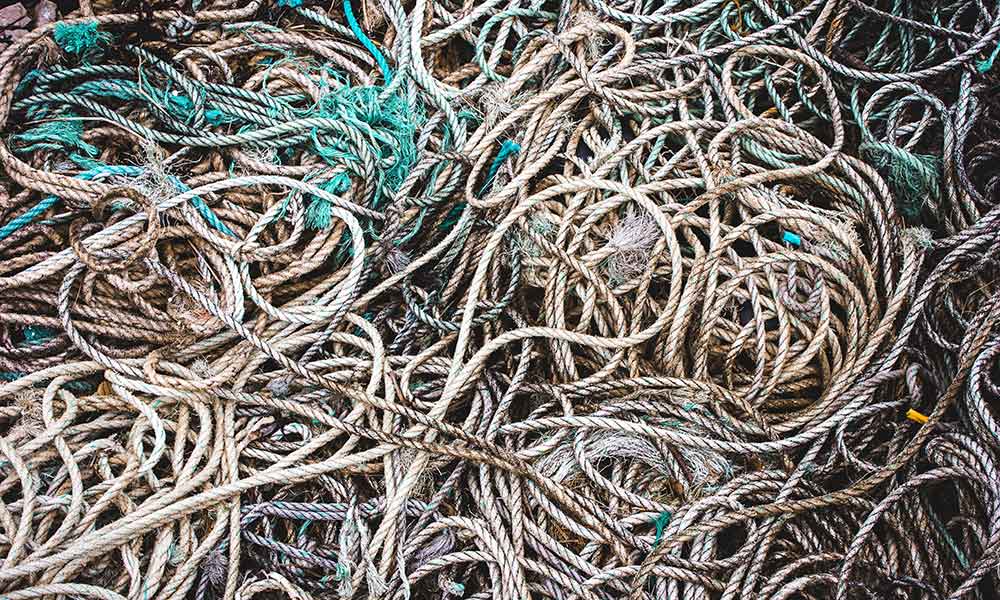A tangled surfboard leash is a sure-fire way to ruin your day. It’s happened to every surfer at some time or another. You see a big wave coming, paddle in, pop up, and then realize that the leash is wrapped around your leg, destroying any hope you had of a clean ride.
You can’t prevent a surfboard leash from tangling every single time, but there are a few things you can do to reduce these incidents.
How to Stop a Surfboard Leash From Tangling
You only need to have a tangled leash one time to realize you never want it to happen again, especially if it ruins your ride. To keep that rubberized boa constrictor from frustrating you on the waves, try these tips:
Don’t Loop It
Surf leashes are often looped before sale, making it easier to store and display them. But they will try to return to this shape as soon as they are unfurled, and this can lead to tangles during your surf sessions.
After you buy the leash, unfurl it, and stretch it out. Hold it in that position for a couple of minutes and then let go. Keep repeating that process until it no longer coils.
Get a “Tangle-Free” Comp Leash
Although there is no such thing as a tangle-free leash, there are leashes that will tangle less than others.
They tend to be a little more expensive, but they’re worth it, as they’ll save you a lot of hassle and frustration on the waves. The FCS Freedom Helix Comp Leash is a great example.
“Tangle-free leashes” are basically high-performance comp leashes, which means they are also designed to deliver less drag and more performance. They might not be a cost-effective option for beginners, but if you’re an experienced surfer looking for every edge you can get, they’re well worth the added expense.
Get a Longer Leash
If you’re buying a regular leash, make sure it’s long enough. It should be roughly as long as your surfboard, and you can err on the longer side if needed.
Wear It Properly
Wear your leash on your back foot and position the cuff so that it sticks out and not in. This means pointing it to the right if you’re a regular footer and to the left if you’re a goofy footer.
Don’t wrap the leash around your surfboard. It might seem like a good option, but it will just create kinks in the leash and could cause tangles.
Change Your Leash As Needed
Your leash won’t last forever. The more it’s used, the shorter its lifespan will be. Eventually, it will lose its stretch and this could cause more tangles.
It’s all about how many times the leash has been pulled. If you’re tackling big waves every day, that might be just a few months. If you’re surfing small waves every week or two, it could last for years. Pay attention to the pull, shape, and strength, and as soon as you notice a big difference, consider buying a new one.
Can I Surf Without a Leash?
The only way to prevent tangling 100% of the time is to not wear a leash at all. But that leash is there for a reason, and the occasional tangle is a small price to pay to prevent constantly chasing after your surfboard.
It will save you a lot of effort in the water, allowing you to spend more time surfing and less time recovering your surfboard. It could also save your life, as it means you can use your surfboard to stay afloat when you’re caught in a strong rip current.
How Do You Store A Surf Leash?
The best way to store your leash is to wrap it around your surfboard, going lengthways and not widthways. Pull it around the back of the surfboard, along the fin (to keep it taut all the way), and then wrap it around the nose before securing with the cuff. It takes a little practice, but once you get this technique down, you’ll be able to store your leash so that’s taut, secure, and never leaves your surfboard.
Are Coiled Leashes Good For Surfing?
Coiled leashes for best-suited to flat water paddling and can also be used for surfing small waves. Generally, however, you’re much better off with a straight leash when surfing.
What Are Comp Surfboard Leashes?
“Comp” is short for “competition”. A comp leash is designed to be thinner, allowing for less drag. This is important for small wave high-performance surfing, as it gives the surfer every possible advantage.
You likely won’t notice much of a difference if you’re a beginner longboard surfer, though. That’s not to say that only pros can benefit from comp leashes, but rather that you have more important things to focus on as an amateur, including the length, volume, and style of surfboard that you’re riding.







